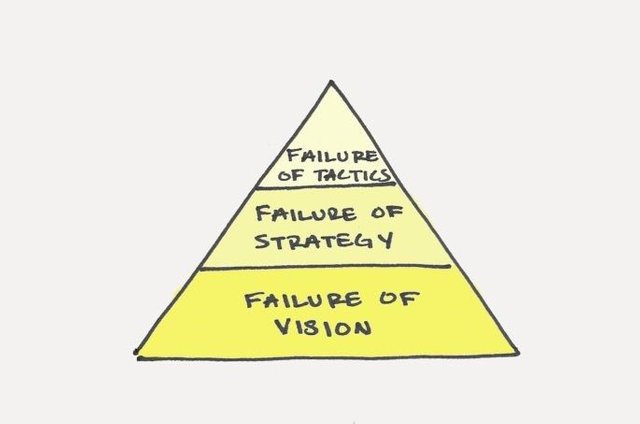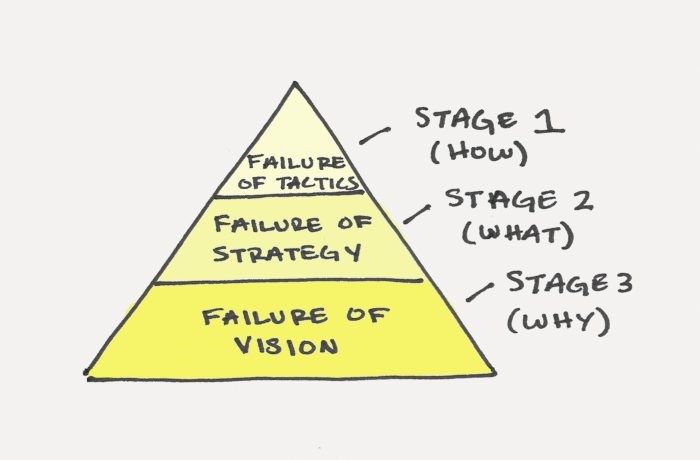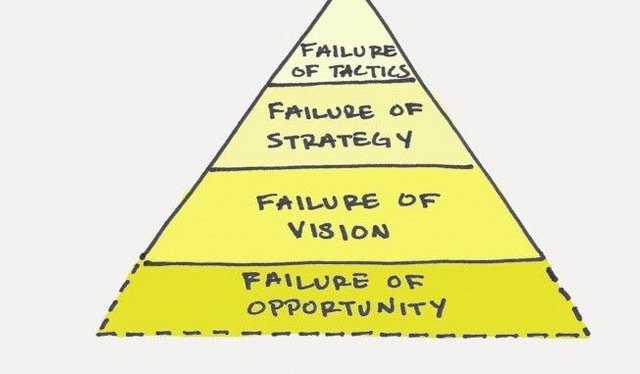One of the hardest things in life is to know when to continue onward and when to proceed onward.
From one perspective, steadiness and coarseness are critical to making progress in any field. Any individual who experts their art will confront snapshots of uncertainty and by one means or another locate the inward take steps to continue onward. On the off chance that you need to construct a fruitful business or make an awesome marriage or take in another aptitude then "staying with it" is maybe the most basic attribute to have.
Then again, advising somebody to never surrender is horrendous counsel. Fruitful individuals surrender constantly. In the event that something isn't working, brilliant individuals don't rehash it unendingly. They overhaul. They change. They turn. They quit. As the truism goes, "Craziness is doing likewise again and again and expecting distinctive outcomes."
Life requires the two systems. Some of the time you have to show immovable certainty and twofold down on your endeavors. At times you have to surrender the things that aren't working and have a go at something new. The key inquiry is: how would you know when to surrender and when to stay with it?
One approach to answer this inquiry is to utilize a system I call the 3 Stages of Failure.

3 Stages of Failure
The 3 Stages of Failure
This system clears up things by separating challenges into three phases of disappointment:
Stage 1
is a Failure of Tactics. These are HOW botches. They happen when you neglect to assemble hearty frameworks, neglect to quantify precisely, and get sluggish with the points of interest. A Failure of Tactics is an inability to execute on a decent arrangement and an unmistakable vision.
Stage 2
is a Failure of Strategy. These are WHAT botches. They happen when you take after a procedure that neglects to convey the outcomes you need. You can know why you do the things you do and you can know how to take the necessary steps, yet at the same time pick the wrong what to get it going.
Stage 3
is a Failure of Vision. These are WHY botches. They happen when you don't set an unmistakable course for yourself, take after a dream that doesn't satisfy you, or generally neglect to comprehend why you do the things you do.
In whatever is left of this article, I'll share a story, arrangement, and synopsis for each phase of disappointment. My expectation is that the 3 Stages of Failure structure will enable you to explore the precarious choice of choosing when to stop and when to stay with it. It's not immaculate, but rather I trust you observe it to be helpful.
Before we discuss how to begin, I needed to tell you I inquired about and accumulated science-upheld approaches to stick to great propensities and quit tarrying. Need to look at my experiences? "Change Your Habits" here.
3 Stages of Failure clarified

Stage 1: A Failure of Tactics
Sam Carpenter turned into an entrepreneur in 1984. Utilizing $5,000 as an up front installment, he bought a battling business in Bend, Oregon and renamed it Centratel.
Centratel gave day in and day out phone voice-mail for specialists, veterinarians, and different organizations that required the telephones to be replied at extremely inconvenient times, however couldn't stand to pay a staff part to sit at the work area always. When he purchased the business, Carpenter trusted that Centratel "would sometime be the most astounding quality phone voice-mail in the United States."
Things did not go not surprisingly. In a 2012 meeting, Carpenter portrayed his first decade and a half of enterprise by saying,
"I was truly working 80 to 100 hours every week for a long time. I was a solitary parent of two children, trust it or not. I was extremely wiped out. I was on a wide range of antidepressants et cetera…
I would miss a finance and lose my whole organization. In the event that you can simply envision an apprehensive wreck, physical wreck, and after that duplicate that by ten, that is the thing that I was. It was an unpleasant time."
One night, just before he was going to miss finance, Carpenter had an acknowledgment. His business was battling on the grounds that it totally did not have the frameworks it expected to accomplish ideal execution. In Carpenter's words, "We were having a wide range of issues since everyone was doing it the way that they thought was ideal."
Woodworker contemplated that in the event that he could consummate his frameworks, at that point his staff could spend every day following accepted procedures rather than continually putting out flames. He instantly started recording each procedure inside the business.
"For example," he said. "We have a nine-advance technique for picking up the telephone at the front work area. Everyone does it that way, it's 100% the most ideal approach to do it, and we've taken a natural framework and made it mechanical, and made it idealize."
Throughout the following two years, Carpenter recorded and updated each procedure in the organization. The most effective method to make a business introduction. The most effective method to store a check. The most effective method to pay customer solicitations. Step by step instructions to process finance. He made a manual that any worker could get and take after for any technique inside the organization—framework by framework, well ordered.
What was the deal?
Woodworker's week's worth of work quickly diminished from 100 hours for every week to under 10 hours for every week. He was never again expected to deal with each crisis in light of the fact that there was a methodology to manage workers in every circumstance. As the nature of their work enhanced, Centratel raised their costs and the organization's net revenue detonated to 40 percent.
Today, Centratel has developed to almost 60 workers and as of late commended its 30th year in business. Craftsman now works only two hours for each week.
Settling a Failure of Tactics
A Failure of Tactics is a HOW issue. For Centratel's situation, they had an unmistakable vision (to be "the most astounding quality phone voice-mail in the United States") and a decent system (the market for phone voice-mail was vast), however they didn't know how to execute their methodology and vision.
There are three essential approaches to settle Failures of Tactics.
Record your procedure.
Measure your results.
Survey and change your strategies.
Record your procedure. McDonald's has more than 35,000 areas around the world. For what reason would they be able to fitting and-play new representatives while as yet conveying a predictable item? Since they have executioner frameworks set up for each procedure. Regardless of whether you're maintaining a business, child rearing a family, or dealing with your own life, building awesome frameworks is pivotal for rehashed achievement. Everything begins with recording every particular advance of the procedure and building up an agenda you can take after when life gets insane.
Measure your results. In the event that something is critical to you, measure it. In case you're a business person, measure what number of offers calls you make every day. In case you're an essayist, measure how every now and again you distribute another article. In case you're a weightlifter, measure how regularly you prepare. On the off chance that you never measure your outcomes, in what manner will you know which strategies are working?
Audit and modify your strategies. The exhausting thing about Stage 1 disappointments is that they never stop. Strategies that used to work will end up out of date. Strategies that were a terrible thought beforehand may be a smart thought now. You should be continually assessing and enhancing how you do your function. Fruitful individuals routinely abandon strategies that don't move their methodology and vision forward. Settling a Failure of Tactics isn't a one time work, it is a way of life.
Stage 2: A Failure of Strategy
It was March of 1999. Jeff Bezos, the organizer of Amazon, had recently declared that his organization would dispatch another administration called Amazon Auctions to enable individuals to offer "essentially anything on the web." The thought was to make something that could contend with eBay. Bezos knew there were a large number of individuals with merchandise to offer and he needed Amazon to be where those exchanges happened.
Greg Linden, a product design for Amazon at the time, reviewed the task by saying, "In the background, this was a huge exertion. Individuals from around the organization were pulled off their ventures. The whole Auctions site, with every one of the highlights of eBay and that's only the tip of the iceberg, was worked sans preparation. It was planned, architected, created, tried, and propelled in less than three months."
Amazon Auctions was a terrific disappointment. Only a half year after dispatch, administration understood the task was going no place. In September 1999, they mixed to discharge another offering called Amazon zShops. This rendition of the thought enabled anybody from huge organizations to people to set up an online shop and offer products through Amazon.
Once more, Amazon swung and missed. Neither Amazon Auctions nor Amazon zShops are running today. In December 2014, Bezos alluded to the fizzled extends by saying, "I've made billions of dollars of disappointments at Amazon.com. Truly billions."
Steadfast, Amazon attempted once more to make a stage for outsider venders. In November 2000, they propelled Amazon Marketplace, which enabled people to offer utilized items close by Amazon's new things. For instance, a little book shop could list their utilized course readings specifically close by new ones from Amazon.
It worked. Commercial center was a runaway achievement. In 2015, Amazon Marketplace represented almost 50 percent of the $107 billion in deals on Amazon.com.
Settling a Failure of Strategy
A Failure of Strategy is a WHAT issue. By 1999, Amazon had an unmistakable vision to "be earth's most client driven organization." They were likewise experts of completing things, which is the reason they could move Amazon Auctions out in only three months. The why and how were dealt with, yet the what was obscure.
There are three essential approaches to settle Failures of Strategy.
Dispatch it rapidly.
Do it economically.

Reexamine it quickly.
Dispatch it rapidly. A few thoughts work much superior to others, however no one truly knows which thoughts work until the point that you attempt them. No one knows early—not financial speculators, not the insightful people at Amazon, not your companions or relatives. The greater part of the arranging and research and configuration is simply affection. I adore Paul Graham's interpretation of this: "You haven't generally begun dealing with [your idea] till you've propelled."